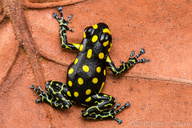|
Ranitomeya vanzolinii (Myers, 1982)
Spotted Poison Frog | family: Dendrobatidae subfamily: Dendrobatinae genus: Ranitomeya |
 © 2013 John P. Clare (1 of 8) |
|
|
|
Description Other dendrobatids also have similar reticulation on the limbs and similar hand structure (Adelphobates quinquevittatus, Ranitomeya fantastica, Ranitomeya reticulatus). However, these three dendrobatid species have different patterning on the dorsum, with lines, reticulation, or uniform coloration being present. In contrast, Ranitomeya vanzolinii is the only one with rounded spots on the dorsum and thus can be easily distinguished. (Myers, 1982). Distribution and Habitat Country distribution from AmphibiaWeb's database: Brazil, Peru
Life History, Abundance, Activity, and Special Behaviors Ranitomeya vanzolinii form pair bonds and exhibit biparental care, in which males and females remain in pairs to care for their young and feed them. Both pair bonding and biparental care are unusual for anurans. Ranitomeya vanzolinii is the only frog species so far for which pair bonding has been observed in the wild. During the course of a two-month study, pairs generally appeared to be monogamous, with females remaining within the territories of their mates (Caldwell and De Oliveira, 1999). However, Caldwell and De Oliveira (1999) did observe one male consorting with two females within his territory. Males vocalize frequently, both in defense of their territory and to communicate with females through both advertisement and courtship calls (Caldwell, 1997; Caldwell and De Oliveira, 1999). Following courtship and fertilization, a clutch consisting of one to several fertilized eggs is deposited inside a small tree hole containing water, above the cavity's waterline. The tree holes are quite small, with the average size being 3.0 x 1.7 cm and 17.9 cm deep. Primarily holes in saplings and woody vines are used, with preferred cavities located about 1.2 m above the forest floor. The cavities contain very little water, less than 18 ml on average. No sunlight enters the tiny openings, precluding algal growth in the water of the treehole. The diminutive size of the openings also means detritus and macroinvertebrates such as mosquitoes are not found in the water. Hence there is no source of food for tadpoles in the treeholes (Caldwell, 1997; Caldwell and De Oliveira, 1999). Tadpoles are reared singly. If the parents deposit more than one fertilized egg in the treehole, the additional tadpoles are not allowed to fall in the water, where they might be consumed by a sibling. Instead, on hatching, a tadpole crawls onto the male's back and is transported individually by the male parent to another treehole containing water. A few days later the male guides the female to the new treehole containing their tadpole, using vocalizations (Caldwell, 1997). When the pair enters the cavity, the frogs court, with the male continuing to call during courtship. Parents remain in the treehole for 2-3 hours. Periodically during this time the female submerges her posterior half into the water, with the male calling more softly and sometimes also entering the water alongside her. When the female is in the water, the tadpole apparently communicates with her by approaching her vent and making rapid swimming movements. Presumably this signals the female to deposit an unfertilized egg for the tadpole to consume (Caldwell and De Oliveira, 1999). The majority of eggs deposited for larval consumption are unfertilized (Caldwell, 1997). Tadpoles are not fed every day. The parents return at approximately five-day intervals (with a range of 1.73-8.5 days) to court each other and feed the offspring (Caldwell, 1997). Females deposit 1-2 eggs at each feeding (Caldwell and De Oliveira, 1999). Tadpoles have serrated jaw sheaths, facilitating tearing of the outer egg envelope. The yolk of the unfertilized egg is consumed by the tadpole but the outer egg jelly capsule is not. (Caldwell, 1997; Caldwell and De Oliveira, 1999). Adults hunt during the day and their diet consists mainly of tiny ants and mites. (Caldwell and Summers, 2003). This species appears to be present at high density in the region where it is found, with male territories often adjacent to one another (Caldwell and De Oliveira, 1999). Trends and Threats Possible reasons for amphibian decline General habitat alteration and loss
References
Brown J.L., Twomey E., Amézquita A., De Souza M.B., Caldwell J.P., Lötters S., Von May R., Melo-Sampaio P.R., Mejía-Vargas D., Perez-Peña P., Pepper M., Poelman E.H., Sanchez-Rodriguez M., and Summers K. (2011). "A taxonomic revision of the Neotropical poison frog genus Ranitomeya (Amphibia: Dendrobatidae)." Zootaxa, 3083, 1-120. [link] Caldwell, J. P. (1997). ''Pair bonding in spotted poison frogs.'' Nature, 385, 211-211. Caldwell, J. P., and De Oliveira, V. R. L. (1999). ''Determinants of biparental care in the Spotted Poison Frog, Dendrobates vanzolinii (Anura: Dendrobatidae).'' Copeia, 1999(3), 565-575. Caldwell, J. P., and Summers, K. D. (2003). ''Brazilian poison frog, Dendrobates vanzolinii.'' Grzimek's Animal Life Encyclopedia, Volume 6, Amphibians. 2nd edition. M. Hutchins, W. E. Duellman, and N. Schlager, eds., Gale Group, Farmington Hills, Michigan. Myers, C.W. (1982). ''Spotted poison frogs: Descriptions of three new Dendrobates from western Amazonia, and resurrection of a lost species from ''Chiriqui''.'' American Museum Novitates, 2721, 1-23. Originally submitted by: Kellie Whittaker, Peera Chantasirivisal (first posted 2005-10-20) Edited by: Kellie Whittaker, taxonomy Michelle S. Koo (2012-01-26) Species Account Citation: AmphibiaWeb 2012 Ranitomeya vanzolinii: Spotted Poison Frog <https://amphibiaweb.org/species/1648> University of California, Berkeley, CA, USA. Accessed Jan 21, 2025.
Feedback or comments about this page.
Citation: AmphibiaWeb. 2025. <https://amphibiaweb.org> University of California, Berkeley, CA, USA. Accessed 21 Jan 2025. AmphibiaWeb's policy on data use. |



 Map of Life
Map of Life